|
|
|
Sort Order |
|
|
|
Items / Page
|
|
|
|
|
|
|
| Srl | Item |
| 1 |
ID:
093149
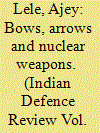

|
|
|
| 2 |
ID:
141027
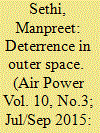

|
|
|
| 3 |
ID:
164128
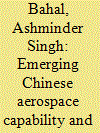

|
|
|
|
|
| Summary/Abstract |
The Ninth Century Chinese alchemists discovered black powder while searching for the elixir of life. this accidental discovery led to experiments for weapons such as bombs, cannon, incendiary arrows and rocket-propelled fire arrows.1 The Chinese were the first to develop a rocket around 1212 AD and used them in a war with Mongols. During the battle of Kai-Keng, they used “arrows of flying fire”. This arrow was a simple form of a solid-propellant rocket.2 From development of simple rockets to anti-satellite weapons, China has progressed rapidly in its aerospace offensive capabilities and the anti-satellite test carried out by China in Jan 2007 demonstrated that the development of anti-satellite (ASAT) technologies created an environment in which civil and military satellites increasingly came under the risk of attack. In response, Dr. Saraswat stated that India had “all the building blocks necessary” for an anti-satellite weapon. The propulsion module and kill vehicle existed in principle; the weapon could be developed in totality soon.3 Yet, the moot question is whether India is ready to face the rapid Chinese modernization onslaught?
|
|
|
|
|
|
|
|
|
|
|
|
|
|
|
|
| 4 |
ID:
110122
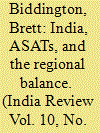

|
|
|
| 5 |
ID:
130043
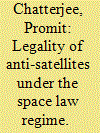

|
|
|
|
|
| Publication |
2014.
|
| Summary/Abstract |
The term anti-satellite, or in short ASAT, is used to refer to a system designed to destroy or damage satellites. The heightened tendency among the spacefaring nations to develop ASAT technology in the recent past has led to widespread debates as to the legality of ASAT deployment under the space law regime. In this context, I have endeavored to make a detailed analysis of the international legal provisions to find if there is any legal basis at all for the deployment of such ASATs. I have concluded that none of the existing legal provisions in space law, as well as public international law, have sufficient force and clarity to bring about a blanket ban on ASAT weapons. Therefore, the research suggests a slew of reforms to overcome this anomaly. Examples of such proposed reforms include, inter alia, an amendment of the Outer Space Treaty and an enhanced role and influence of the United Nations in treaty making coupled with active diplomatic initiatives.
|
|
|
|
|
|
|
|
|
|
|
|
|
|
|
|
| 6 |
ID:
142593
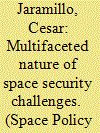

|
|
|
|
|
| Summary/Abstract |
The challenges facing the space domain are multifaceted and there need not be an expectation that they all be covered by a single initiative. Accordingly, no single space policy proposal will effectively address all challenges to the sustainability of outer space—from environmental to commercial to military. Should one of the existing proposals be adopted, it can make a concrete contribution to space governance, in particular if its adoption is not taken as an end goal that jeopardizes the pursuit of further complementary initiatives.
|
|
|
|
|
|
|
|
|
|
|
|
|
|
|
|
| 7 |
ID:
183788
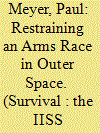

|
|
|
|
|
| Summary/Abstract |
The world is faced with an escalating arms race in outer space at the very time that this vital, if vulnerable, environment is experiencing rapid growth in orbiting satellites and the array of services they provide. After years of relative stagnation, multilateral diplomatic activity is being re-energised, spurred by the revival of debris-causing anti-satellite weapons (ASAT) tests. A British initiative has resulted in the creation of a new United Nations diplomatic forum on ‘Reducing Space Threats Through Norms, Rules and Principles of Responsible Behaviours’. Although geopolitical tensions between leading space powers make the development of cooperative security arrangements difficult, there is a common interest in avoiding the creation of more space debris that would endanger the assets of all space operators.
|
|
|
|
|
|
|
|
|
|
|
|
|
|
|
|
| 8 |
ID:
100221
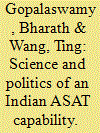

|
|
|
|
|
| Publication |
2010.
|
| Summary/Abstract |
India has recently stated an intention to develop an anti-satellite (ASAT) capability. The reasons for this may include the country's growing economic and political clout, alongside the increasing importance of space to this status, the significance of space assets to the military, a perceived threat from China, and fear of being disadvantaged in future treaty negotiations if not 'in the club'. Nevertheless, development and use of an ASAT would have potentially catastrophic debris-related consequences that would also create major political problems for the user. The state of India's ASAT activities is described and recommendations on avoiding hasty development, such as researching methods of protecting satellites, strengthening bilateral relations with China and pushing for a legally binding norm on ASATs, are made.
|
|
|
|
|
|
|
|
|
|
|
|
|
|
|
|
| 9 |
ID:
142594
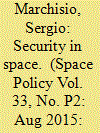

|
|
|
|
|
| Summary/Abstract |
When discussing international texts and measures for improving security in space, one has to use precise terminology in order for any negotiating party to be clear with definitions. In the context of space security, several texts are being prepared to deal with this issue with different perspectives. Beyond the sole diplomatic aspect of these different proposals, it is important to make sure that they can be efficient in practice. In this respect, the Eu initiated project of an international code of conduct may prove to be a first important so called “transparency and confidence building measure” in space.
|
|
|
|
|
|
|
|
|
|
|
|
|
|
|
|
| 10 |
ID:
162149
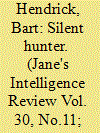

|
|
|
| 11 |
ID:
166209
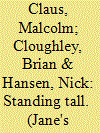

|
|
|
| 12 |
ID:
169316


|
|
|
|
|
| Summary/Abstract |
Outer space is a congested strategic domain. The issue of space debris mitigation is one of the key issues of safe space traffic. However, active debris removal (ADR) systems may raise concerns about their dual-use capabilities. In this article, the authors have analyzed the ADR systems focusing on their potential as space weapons. The article concludes that ADR systems can be utilized for harmful purposes, although with limited impact. This limited potential of ADR systems to become antisatellite weapons allow for the development of such systems keeping in place basic confidence and trust building measures. The authors believe the further commercialization of space sector could enhance the space debris mitigation efforts.
|
|
|
|
|
|
|
|
|
|
|
|
|
|
|
|
| 13 |
ID:
097107
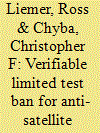

|
|
|
|
|
| Publication |
2010.
|
| Summary/Abstract |
The growing number of actors pursuing sophisticated outer space programs gives rise to one of the more novel challenges of the global commons. Once the privileged domain of the United States and the Soviet Union, space now accommodates a larger set of countries seeking to enhance their defense capabilities. In January 2007, perhaps most notably, China tested an anti-satellite (ASAT) missile, destroying Fengyun-1C, an old Chinese weather satellite. The weapon was a kinetic-energy ASAT, which homed in on its target and shattered it through high-velocity collision at an altitude of 864 km.1 The impact created thousands of debris fragments concentrated in orbits between 800 and 1,000 km,2 approximately doubling the risk of potentially catastrophic collision for satellites in the crowded 800-900 km range.3 Satellites at these altitudes include commercial communications satellites, a U.S. photoreconnaissance satellite, a Chinese earth science satellite, and a Russian electronic intelligence satellite.4 Most of the Fengyun-1C debris will stay in orbit for several decades; some is expected to remain in space for centuries.
|
|
|
|
|
|
|
|
|
|
|
|
|
|
|
|
|
|
|
|
|